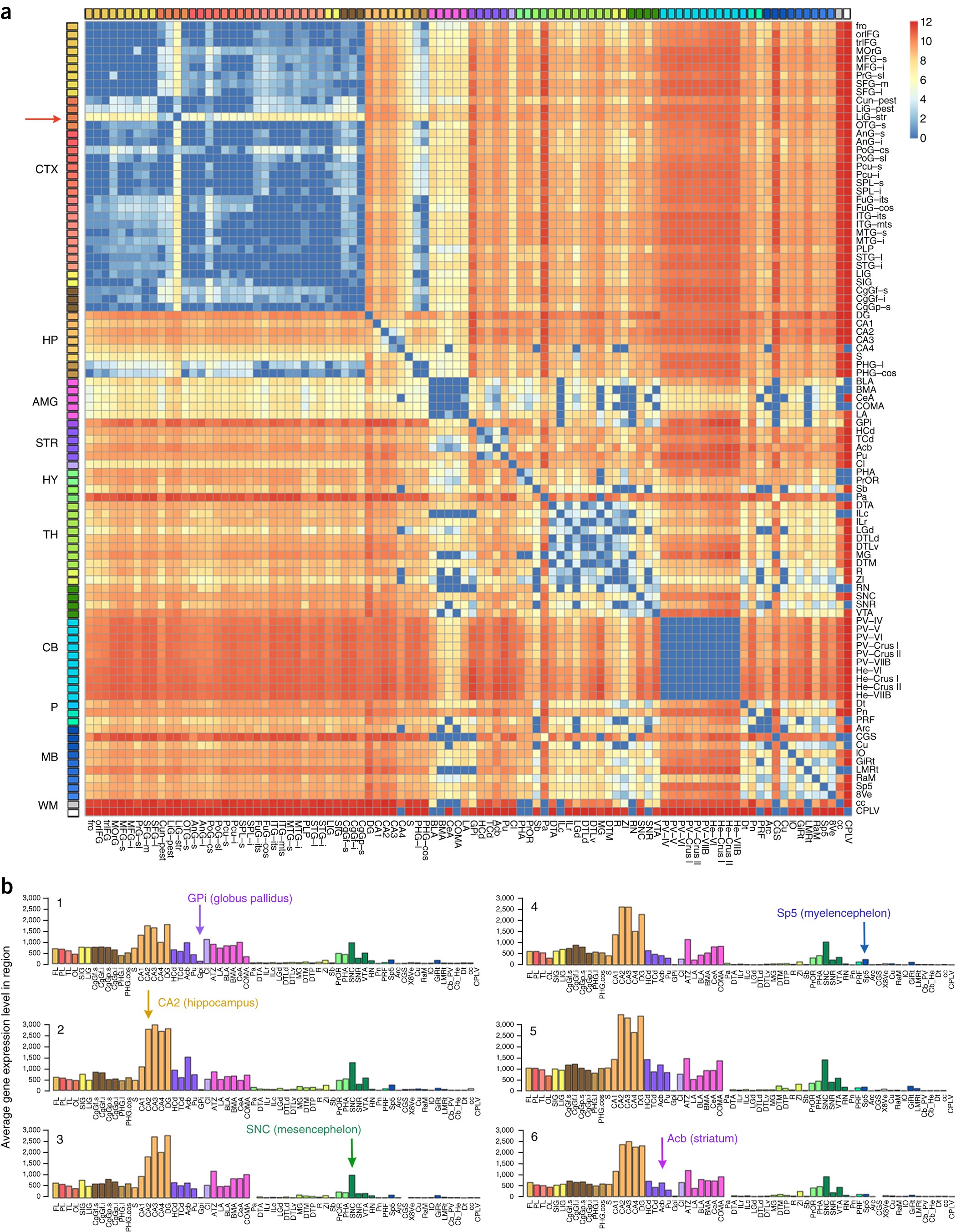doi.org/10.1038/nn.4171
Preview meta tags from the doi.org website.
Linked Hostnames
30- 169 links todoi.org
- 107 links towww.ncbi.nlm.nih.gov
- 48 links toscholar.google.com
- 30 links toscholar.google.co.uk
- 26 links towww.nature.com
- 16 links tostatic-content.springer.com
- 8 links towww.springernature.com
- 4 links tolink.springer.com
Thumbnail

Search Engine Appearance
Canonical genetic signatures of the adult human brain - Nature Neuroscience
The authors applied a correlation-based metric, ‘differential stability’ (DS), to assess reproducibility of gene expression patterning across individual brains, revealing mesoscale genetic organization. The highest DS genes were enriched for brain-related biological annotations, disease associations and drug targets, and their anatomical expression pattern correlated with resting state functional connectivity. The structure and function of the human brain are highly stereotyped, implying a conserved molecular program responsible for its development, cellular structure and function. We applied a correlation-based metric called differential stability to assess reproducibility of gene expression patterning across 132 structures in six individual brains, revealing mesoscale genetic organization. The genes with the highest differential stability are highly biologically relevant, with enrichment for brain-related annotations, disease associations, drug targets and literature citations. Using genes with high differential stability, we identified 32 anatomically diverse and reproducible gene expression signatures, which represent distinct cell types, intracellular components and/or associations with neurodevelopmental and neurodegenerative disorders. Genes in neuron-associated compared to non-neuronal networks showed higher preservation between human and mouse; however, many diversely patterned genes displayed marked shifts in regulation between species. Finally, highly consistent transcriptional architecture in neocortex is correlated with resting state functional connectivity, suggesting a link between conserved gene expression and functionally relevant circuitry.
Bing
Canonical genetic signatures of the adult human brain - Nature Neuroscience
The authors applied a correlation-based metric, ‘differential stability’ (DS), to assess reproducibility of gene expression patterning across individual brains, revealing mesoscale genetic organization. The highest DS genes were enriched for brain-related biological annotations, disease associations and drug targets, and their anatomical expression pattern correlated with resting state functional connectivity. The structure and function of the human brain are highly stereotyped, implying a conserved molecular program responsible for its development, cellular structure and function. We applied a correlation-based metric called differential stability to assess reproducibility of gene expression patterning across 132 structures in six individual brains, revealing mesoscale genetic organization. The genes with the highest differential stability are highly biologically relevant, with enrichment for brain-related annotations, disease associations, drug targets and literature citations. Using genes with high differential stability, we identified 32 anatomically diverse and reproducible gene expression signatures, which represent distinct cell types, intracellular components and/or associations with neurodevelopmental and neurodegenerative disorders. Genes in neuron-associated compared to non-neuronal networks showed higher preservation between human and mouse; however, many diversely patterned genes displayed marked shifts in regulation between species. Finally, highly consistent transcriptional architecture in neocortex is correlated with resting state functional connectivity, suggesting a link between conserved gene expression and functionally relevant circuitry.
DuckDuckGo
Canonical genetic signatures of the adult human brain - Nature Neuroscience
The authors applied a correlation-based metric, ‘differential stability’ (DS), to assess reproducibility of gene expression patterning across individual brains, revealing mesoscale genetic organization. The highest DS genes were enriched for brain-related biological annotations, disease associations and drug targets, and their anatomical expression pattern correlated with resting state functional connectivity. The structure and function of the human brain are highly stereotyped, implying a conserved molecular program responsible for its development, cellular structure and function. We applied a correlation-based metric called differential stability to assess reproducibility of gene expression patterning across 132 structures in six individual brains, revealing mesoscale genetic organization. The genes with the highest differential stability are highly biologically relevant, with enrichment for brain-related annotations, disease associations, drug targets and literature citations. Using genes with high differential stability, we identified 32 anatomically diverse and reproducible gene expression signatures, which represent distinct cell types, intracellular components and/or associations with neurodevelopmental and neurodegenerative disorders. Genes in neuron-associated compared to non-neuronal networks showed higher preservation between human and mouse; however, many diversely patterned genes displayed marked shifts in regulation between species. Finally, highly consistent transcriptional architecture in neocortex is correlated with resting state functional connectivity, suggesting a link between conserved gene expression and functionally relevant circuitry.
General Meta Tags
208- titleCanonical genetic signatures of the adult human brain | Nature Neuroscience
- titleClose banner
- titleClose banner
- X-UA-CompatibleIE=edge
- applicable-devicepc,mobile
Open Graph Meta Tags
6- og:urlhttps://www.nature.com/articles/nn.4171
- og:typearticle
- og:site_nameNature
- og:titleCanonical genetic signatures of the adult human brain - Nature Neuroscience
- og:descriptionThe authors applied a correlation-based metric, ‘differential stability’ (DS), to assess reproducibility of gene expression patterning across individual brains, revealing mesoscale genetic organization. The highest DS genes were enriched for brain-related biological annotations, disease associations and drug targets, and their anatomical expression pattern correlated with resting state functional connectivity.
Twitter Meta Tags
6- twitter:site@natureneuro
- twitter:cardsummary_large_image
- twitter:image:altContent cover image
- twitter:titleCanonical genetic signatures of the adult human brain
- twitter:descriptionNature Neuroscience - The authors applied a correlation-based metric, ‘differential stability’ (DS), to assess reproducibility of gene expression patterning across individual brains,...
Item Prop Meta Tags
5- position1
- position2
- position3
- position4
- publisherSpringer Nature
Link Tags
15- alternatehttps://www.nature.com/neuro.rss
- apple-touch-icon/static/images/favicons/nature/apple-touch-icon-f39cb19454.png
- canonicalhttps://www.nature.com/articles/nn.4171
- icon/static/images/favicons/nature/favicon-48x48-b52890008c.png
- icon/static/images/favicons/nature/favicon-32x32-3fe59ece92.png
Emails
2Links
439- http://scholar.google.com/scholar_lookup?&title=A%20general%20framework%20for%20weighted%20gene%20co-expression%20network%20analysis&journal=Stat.%20Appl.%20Genet.%20Mol.%20Biol.&doi=10.2202%2F1544-6115.1128&volume=4&publication_year=2005&author=Zhang%2CB&author=Horvath%2CS
- http://scholar.google.com/scholar_lookup?&title=A%20polymorphism%20in%20the%20complement%20component%20C1r%20is%20not%20associated%20with%20sporadic%20Alzheimer%27s%20disease&journal=Neurosci.%20Lett.&doi=10.1016%2FS0304-3940%2802%2901218-1&volume=336&pages=101-104&publication_year=2003&author=Rosenmann%2CH
- http://scholar.google.com/scholar_lookup?&title=A%20transcriptome%20database%20for%20astrocytes%2C%20neurons%2C%20and%20oligodendrocytes%3A%20a%20new%20resource%20for%20understanding%20brain%20development%20and%20function&journal=J.%20Neurosci.&doi=10.1523%2FJNEUROSCI.4178-07.2008&volume=28&pages=264-278&publication_year=2008&author=Cahoy%2CJ
- http://scholar.google.com/scholar_lookup?&title=Adult%20mouse%20brain%20gene%20expression%20patterns%20bear%20an%20embryologic%20imprint&journal=Proc.%20Natl.%20Acad.%20Sci.%20USA&doi=10.1073%2Fpnas.0503357102&volume=102&pages=10357-10362&publication_year=2005&author=Zapala%2CMA
- http://scholar.google.com/scholar_lookup?&title=An%20anatomically%20comprehensive%20atlas%20of%20the%20adult%20human%20brain%20transcriptome&journal=Nature&doi=10.1038%2Fnature11405&volume=489&pages=391-399&publication_year=2012&author=Hawrylycz%2CMJ